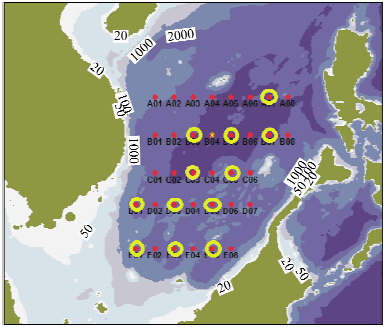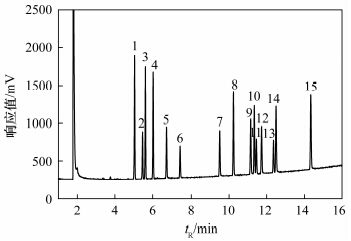Concentrations and Distribution Characteristics of Organochlorine Pesticides and Polychlorinated Biphenyls in Seawaters of the South Sea
-
摘要: 近年来,随着沿海化工生产基地的大量投入运营及海上危险化学品运输业的日益增长,海洋生态环境受到严重威胁,我国海洋环境中持久性有机污染物如有机氯农药及多氯联苯在近海环境中普遍检出。为了对南中国海水体中持久性有机污染物的污染现状有所了解,本文利用气相色谱-电子捕获检测器(GC-ECD)对南中国海海水中的15种有机氯农药和多氯联苯进行测定,两类化合物各检出6种。采用外标法进行定量分析,结果显示:调查海域表层海水中有机氯农药和多氯联苯类化合物的浓度范围分别为0~92.30 ng/L和1.16~76.24 ng/L,200 m层海水中分别为0~69.85 ng/L和0~49.63 ng/L,500 m层海水中分别为0~56.68 ng/L和0~26.47 ng/L。由此可看出,该海域有机氯农药和多氯联苯的含量分布特征大致呈现为:表层>200 m层>500 m层,原因可能是污染源主要来自周围地表径流或大气输入,且随着时间的推移污染物吸附于悬浮体由表层向下层迁移。与国内外相关海洋环境中有机农药及多氯联苯含量水平相比较,南中国海海水中有机农药和多氯联苯的含量低于国内大部分水域,但高于国外已知海洋水体中的含量。南中国海中有机农药和多氯联苯含量和分布特征的取得为下一步对海洋环境的研究和保护工作提供了基础数据。Abstract: In recent years, with the operation of coastal chemical production bases and booming maritime transportation of dangerous chemicals, there are threats to the marine environment. Persistent organic pollutants, such as organochlorine pesticides (OCPs) and polychlorinated biphenyls (PCBs), have been detected in the offshore marine environment. In order to understand the pollution status of persistent organic pollutants (POPs) in the South China Sea, 15 PCBs and OCPs in seawater from the South China Sea were quantitatively determined by using Gas Chromatography- Electron Capture Detector (GC-ECD). Six kinds of OCPs and six kinds of PCBs were detected in these seawater samples. Using an external standard method for quantitative analysis, the detection limits were 0.24-1.07 ng/L, the linear range of the method was 1.0-250 ng/L. The recoveries for blanks were in the range of 89.1% to 109.7% with the relative standard deviations of 2.3%-8.6% and the recoveries for the samples were in the range of 90.1% to 113.5% with the relative standard deviations of 3.1%-10.4%. The results show that the concentration ranges of OCPs and PCBs were 0-92.30 ng/L and 1.16-76.24 ng/L respectively in the surface seawater, 0-69.85 ng/L and 0-49.63 ng/L in seawater from the depth of 200 m, and 0-56.68 ng/L and 0-26.47 ng/L in seawater from the depth of 500 m. The distribution of the contents of OCPs and PCBs tend to be highest in surface water, and lower in 200 m depth layer, and lowest in 500 m depth layer. The main possible pollutant sources are nearby surface runoff and atmospheric input. The pollutants were absorbed by suspended substances and transported from surface to deep seawater column. The detected OCPs and PCBs levels in the South China Sea are lower than those in other offshore marine environments in China, but higher than those in other countries with published data. The concentrations and distribution characteristics of OCPs and PCBs in the South China Sea, provide basic data for future research.
-
不久前,友人发来一封邮件,谈及最近阅读有感。其中有这样一段文字颇值得玩味:当布里斯班的灯鱼轻轻划过五彩斑斓的珊瑚丛时,你在苦战通宵;当蒙巴萨的小蟹溜出渔夫布满老茧的掌心时,你正辗转难眠;当布拉格的电车晃过金色夕阳下的古堡宫殿,你正埋头冥思着软件代码之逻辑……
如若自己此时做了个渔夫,是不是也正大江中一叶扁舟,自在来去?
人人都有青春的憧憬和金色的梦想,人人也都要面对现实的生活,经历奋斗的日时。知足常乐,过一种朴素的生活,是现实中最需要的一种成熟心态。
不仅人生如此,科学的探索也无不因了对于梦想的追寻和对于未知世界的不懈探究而穷无止境。同位素定年与示踪技术由来已久,广为熟知的铅同位素示踪在污染源识别方面起到了重要作用。其它的一些毒性元素是否也有可以作如此利用的可能?周期表中所有的元素都可以被利用或许只是一个梦想,但如果能发现其中的一个或几个,无疑将为解决现实环境地球化学研究中的难点问题,提供重要技术手段。令人欣喜的是,遥远的梦想有时也会来敲门,命运的音符会为我们平凡、朴素的生活增添几分色彩和活力。作为毒性元素之一的镉,其同位素实验测试技术研究已经起步,相信该技术在地球科学、环境科学、生命科学中会很快得到广泛而深入的应用。有兴趣的读者可参见进展与评述中“镉同位素体系及其在地球科学和环境科学中的应用”一文(P181~191)。事实上,进展与评述,是我们目前特别下力去办的栏目,它不是简单的文献堆砌,而是凝聚着作者实践、观察、思考和智慧的结晶。
在线分析和现场分析一直是地质实验测试技术的重要发展方向之一。本期“有机污染物稳定同位素在线测试技术研究”(P192~202)、“现场X射线荧光分析技术”(P203~212)、“地下水硝酸盐15N和18O同位素在线测试技术研究”(P311~318)分别从总体进展和实际应用方面对在线和现场分析技术及其应用作了诠释。
标准物质研制从来都是分析测试技术领域中最基础、最重要的工作之一。如何进行同位素样品的均匀性检验?是否可以用样品年龄值作为特性量值进行检验?相信读者可以从“新生代透长石SK01作为39Ar-40Ar法定年标准物质的均匀性检验”一文中(P213~220)获得有用的参考信息。同样对于现有标准物质进行补充完善(P221~228)自然也是一项务实的基础性工作。
关于“不同颜色的淡水养殖珍珠呈色机理”(P263~268),正如文中所述,并没有统一的认识。该文作者利用其采用的技术和样本,获得了一些数据,提出了相关的观点和看法。本刊在这里刊出,供大家参考。然而不能说该文已经提供了充分的证据,至少没有让读者完全信服。是否可以获得广泛认同,还需要大量的数据检验。但该文为构成机理框架的诸多假设、佐证等研究提供了基础数据,无疑也是十分有益的。同样,“安徽金寨县沙坪沟钼矿区铌赋存状态”一文(P269~277)报道了作者们所进行的探索和研究,给出了结论。其结论也还需要大量数据和多种方法、多种途径的广泛论证。这类探索性强,并需要进一步检验和论证的文章,无疑是我们《岩矿测试》要大力发掘并选择发表的论文。
了解、认知、掌控未知世界的每一个细节,是我们遥远的梦想。对于科学真谛的不懈探索和艰苦追寻过程,是我们平日里最朴素的生活。我们崇尚辛勤的劳动和无私付出,崇尚自由平凡和知足的生活。
新的一年,愿您拥有最朴素的生活和最遥远的梦想!
主编:罗立强
2013年2月18日
贵州雨谷村
-
表 1 南中国海各站位表层海水中OCPs的含量
Table 1 Concentrations of OCPs in the surface seawater at the stations of the South China Sea
站位 ρ/(ng·L-1) α-HCH β-HCH γ-HCH δ-HCH p,p′-DDD p,p′-DDE p,p′-DDT o,p′-DDT ∑OCPs A07 N.D. 43.48 31.08 14.80 N.D. N.D. 2.93 5.10 92.30 B03 N.D. N.D. 0.771 N.D. N.D. N.D. 0.67 N.D. 1.44 B05 N.D. N.D. 14.32 8.68 N.D. 10.72 15.39 11.02 60.14 B07 N.D. N.D. N.D. N.D. N.D. N.D. N.D. 1.55 1.55 C03 N.D. N.D. N.D. N.D. N.D. N.D. 1.72 N.D. 1.72 C05 N.D. 3.53 20.01 N.D. N.D. N.D. 0.86 6.67 31.07 D01 N.D. 0.29 0.57 N.D. N.D. 20.79 53.77 N.D. 75.42 D03 N.D. 8.95 4.94 1.89 N.D. 6.02 13.26 N.D. 35.06 D05 N.D. 45.80 4.21 N.D. N.D. N.D. 5.33 0.62 55.97 E01 N.D. N.D. 1.11 N.D. N.D. N.D. 0.29 N.D. 1.40 E03 N.D. N.D. N.D. N.D. N.D. N.D. N.D. N.D. 0.00 E05 N.D. N.D. N.D. N.D. N.D. N.D. 7.88 N.D. 7.88 检出
率/%0.00 41.67 66.67 25.00 0.00 25.00 83.33 41.67 - 注:“N.D.” 表示该项未检出;“- ” 表示无此项,下表同。 表 2 南中国海各站位200 m层海水中OCPs的含量
Table 2 Concentrations of OCPs in the 200 m depth water at the stations of the South China Sea
站位 ρ/(ng·L-1) α-HCH β-HCH γ-HCH δ-HCH p,p′-DDD p,p′-DDE p,p′-DDT o,p′-DDT ∑OCPs A07 N.D. 12.28 6.11 6.28 N.D. 6.72 7.76 N.D. 39.14 B03 N.D. N.D. N.D. N.D. N.D. N.D. 1.70 N.D. 1.70 B05 N.D. 7.77 N.D. N.D. N.D. N.D. N.D. N.D. 7.77 B07 N.D. N.D. N.D. N.D. N.D. N.D. 2.62 N.D. 2.62 C05 N.D. N.D. N.D. N.D. N.D. N.D. 2.05 N.D. 2.05 D01 N.D. 38.18 N.D. N.D. N.D. N.D. 7.54 N.D. 45.72 D03 N.D. 41.23 4.58 2.75 N.D. 21.29 N.D. N.D. 69.85 D05 N.D. N.D. 16.38 3.86 N.D. N.D. N.D. 21.60 41.84 E01 N.D. N.D. N.D. N.D. N.D. N.D. 2.87 N.D. 2.87 E03 N.D. N.D. N.D. N.D. N.D. N.D. 4.74 N.D. 4.74 E05 N.D. N.D. N.D. N.D. N.D. N.D. N.D. N.D. 0.00 检出
率/%0.00 36.36 27.27 27.27 0.00 18.18 72.73 9.09 - 表 3 南中国海各站位500 m层海水中OCPs的含量
Table 3 Concentrations of OCPs in the 500 m depth water at the stations of the South China Sea
站位 ρ/(ng·L-1) α-HCH β-HCH γ-HCH δ-HCH p,p′-DDD p,p′-DDE p,p′-DDT o,p′-DDT ∑OCPs A07 N.D. 35.73 N.D. N.D. N.D. N.D. N.D. N.D. 35.73 B03 N.D. 3.18 N.D. N.D. N.D. N.D. 7.25 N.D. 10.44 B05 N.D. N.D. N.D. N.D. N.D. 1.48 5.62 N.D. 7.10 B07 N.D. N.D. N.D. 3.80 N.D. N.D. 5.52 N.D. 9.32 C05 N.D. 1.84 N.D. N.D. N.D. 5.53 3.58 5.24 16.19 D01 N.D. 56.68 N.D. N.D. N.D. N.D. N.D. N.D. 56.68 D03 N.D. N.D. N.D. N.D. N.D. N.D. N.D. N.D. 0.00 D05 N.D. 2.30 17.73 4.78 N.D. N.D. N.D. 15.74 40.55 E01 N.D. N.D. N.D. N.D. N.D. N.D. 1.46 N.D. 1.46 E03 N.D. 1.74 N.D. N.D. N.D. N.D. 1.19 N.D. 2.93 E05 N.D. N.D. N.D. N.D. N.D. N.D. N.D. N.D. 0.00 检出
率/%0.00 54.55 9.09 18.18 0.00 18.18 72.73 36.36 - 表 4 南中国海各站位表层海水中PCBs的含量
Table 4 Concentrations of PCBs in the surface seawater at the stations of the South China Sea
站位 ρ/(ng·L-1) PCB 28 PCB 52 PCB 101 PCB 118 PCB 138 PCB 153 PCB 180 ∑PCBs A07 49.98 N.D. 1.70 N.D. 1.12 1.33 1.96 56.10 B03 N.D. N.D. 1.01 N.D. N.D. 1.06 N.D. 2.03 B05 25.18 N.D. 24.70 4.91 N.D. 3.07 1.54 59.40 B07 N.D. N.D. 3.31 N.D. N.D. 1.08 N.D. 4.40 C03 N.D. N.D. N.D. N.D. N.D. 1.16 N.D. 1.16 C05 N.D. N.D. 20.41 N.D. N.D. 2.79 1.05 24.24 D01 2.77 N.D. 6.81 8.68 49.41 8.56 N.D. 76.24 D03 13.04 N.D. 5.29 1.88 7.86 5.67 1.11 34.84 D05 N.D. N.D. N.D. N.D. N.D. 1.37 2.32 4.01 E01 N.D. N.D. N.D. N.D. N.D. 2.53 N.D. 2.53 E03 N.D. N.D. N.D. N.D. N.D. 1.24 N.D. 1.24 E05 N.D. N.D. N.D. N.D. N.D. 4.11 N.D. 4.11 检出
率/%33.33 0.00 58.37 25.00 33.31 100.00 41.67 - 表 5 南中国海各站位200m层海水中PCBs的含量
Table 5 Concentrations of PCBs in the 200 m depth water at the stations of the South China Sea
站位 ρ/(ng·L-1) PCB 28 PCB 52 PCB 101 PCB 118 PCB 138 PCB 153 PCB 180 ∑PCBs A07 9.78 N.D. 26.28 2.16 3.89 5.99 1.53 49.63 B03 N.D. N.D. N.D. N.D. N.D. 1.05 N.D. 1.05 B05 N.D. N.D. N.D. N.D. N.D. N.D. N.D. 0.00 B07 N.D. N.D. N.D. N.D. N.D. 1.06 N.D. 1.06 C05 N.D. N.D. N.D. N.D. N.D. 1.00 N.D. 1.00 D01 N.D. N.D. 1.55 N.D. 1.05 N.D. N.D. 2.60 D03 3.86 N.D. 4.33 1.15 4.28 3.88 1.43 18.93 D05 N.D. N.D. N.D. N.D. N.D. 8.52 N.D. 8.52 E01 N.D. N.D. N.D. N.D. N.D. N.D. N.D. 0.00 E03 N.D. N.D. N.D. N.D. N.D. 15.33 N.D. 15.33 E05 N.D. N.D. N.D. N.D. N.D. N.D. N.D. 0.00 检出
率/%18.18 0.00 27.27 18.18 27.27 63.64 18.18 - 表 6 南中国海各站位500 m层海水中PCBs的含量
Table 6 Concentrations of PCBs in the 500m depth water at the stations of the South China Sea
站位 ρ/(ng·L-1) PCB 28 PCB 52 PCB 101 PCB 118 PCB 138 PCB 153 PCB 180 ∑PCBs A07 N.D. N.D. N.D. N.D. N.D. N.D. N.D. 0.00 B03 9.22 N.D. 3.11 N.D. N.D. 12.82 1.32 26.47 B05 N.D. N.D. 1.26 N.D. N.D. 1.22 N.D. 2.48 B07 N.D. N.D. 3.21 2.17 N.D. N.D. N.D. 5.38 C05 N.D. N.D. 14.63 1.71 N.D. 2.83 N.D. 19.17 D01 N.D. N.D. N.D. N.D. N.D. N.D. N.D. 0.00 D03 N.D. N.D. N.D. N.D. N.D. N.D. 1.18 1.18 D05 N.D. N.D. 1.11 N.D. N.D. 1.84 N.D. 2.95 E01 N.D. N.D. 16.79 N.D. N.D. 1.05 N.D. 17.84 E03 N.D. N.D. N.D. N.D. N.D. N.D. 1.33 1.33 E05 N.D. N.D. N.D. N.D. N.D. N.D. N.D. 0.00 检出
率/%9.09 0.00 54.55 18.18 0.00 45.45 27.27 - 表 7 本文南中国测定值与其他水体的比较
Table 7 Comparison of the levels of PCBs and OCPs in the South China Sea and those in other sea areas
海域 ρ/(ng·L-1) 采样时间 参考文献 PCBs HCHs DDTs 海河 310~3110
(760)300~1070
(660)9~152
(76)2004年8月 [4] 闽江 204~2470
(985)52~515
(206)46.1~235
(142)2002年9月 [10] 渤海湾 60~710
(210)50~750
(160)N.D~105
(35.9)2004年8月 [4] 莱州湾 4.5~27.7
(5.4)N.D~42.2
(3.246)N.D~9.1
(2.0)2004年9月 [11] 桑沟湾 11.22~92.43
(36.86)12.75~42.10
(21.49)5.37~34.4
(18.82)2009年3月 [5] 大亚湾 91.1~1355.3 35.5~1230
(285)26.8~975.9
(174.95)1999年8月 [12] 珠江口 0.19~7.04
(1.80)1.38~99.7
(46.1)5.33~9.53
(7.81)2001年
2005年[13],[14] 白洋淀 19.46~131.6
(45.35)300~2000
(1400)N.D~900
(250)1995年
2008年[15],[16] 厦门西港 0.08~1.69 3.51~27.8
(8.57)0.95~2.25
(1.45)1998年7月 [17] 南波罗的海 0.24~2.07
(0.97)0.18~0.75
(0.40)0.05~0.32
(0.16)2003年 [18] 南中国海 6.55~22.20
(12.50)12.78~14.20
(13.64)4.55~13.29
(8.14)2010年 本研究 注:括号内数据表示平均值。




 下载:
下载:

 京公网安备 11010202008159号
京公网安备 11010202008159号